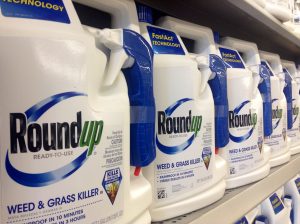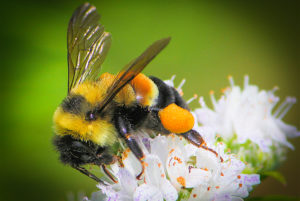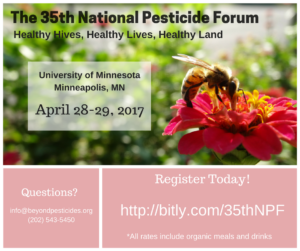(Beyond Pesticides, March 22, 2017) Today, a coalition of farmers and environmental and public health organizations filed a lawsuit against the Environmental Protection Agency (EPA) for approving agrochemical giant Dow Chemicalâs toxic pesticide combo, Enlist Duo, among the newer more highly toxic pesticide mixtures used in genetically engineered (GE) herbicide-tolerant crops. Comprised of glyphosate and 2,4-D (50% of the mixture in the warfare defoliant Agent Orange), Enlist Duo is typically marketed alongside commercial crops like corn, cotton and soybeans that are engineered to withstand pesticide exposure, leading to problems of resistance and driving the evolution of super weeds. This is the third lawsuit challenging EPA approval of Enlist Duo by petitioners, which include Beyond Pesticides, National Family Farm Coalition, Family Farm Defenders, Pesticide Action Network North America, Center for Food Safety, and Center for Biological Diversity, represented jointly by legal counsel from Earthjustice and Center for Food Safety.
The lawsuit charges that approval of Enlist Duo âwill lead to sharply increased spraying o f toxic pesticides, harming farmers, neighboring crops, and wildlife.â Specifically farmersâ health and financial positions stand to be heavily impacted by the approval of Enlist Duo, as increased use will result in increased pesticide drift, an alarming concern especially for organic farmers. The U.S. Department of Agriculture (USDA) projects that the approval of Enlist Duo will lead to as much as a seven-fold increase in its use in agriculture, significantly increasing exposure to farmers.
f toxic pesticides, harming farmers, neighboring crops, and wildlife.â Specifically farmersâ health and financial positions stand to be heavily impacted by the approval of Enlist Duo, as increased use will result in increased pesticide drift, an alarming concern especially for organic farmers. The U.S. Department of Agriculture (USDA) projects that the approval of Enlist Duo will lead to as much as a seven-fold increase in its use in agriculture, significantly increasing exposure to farmers.
Developed by Dow AgroSciences (Dow), Enlist Duo is an herbicide that incorporates a mix of glyphosate and a new formulation of 2,4-D, intended for use on GE Enlist-Duo-tolerant corn and soybean crops. The product formulation also contains unlisted inert ingredients, which are any ingredients that are not specifically included to target a pest, but can be biologically and chemically active and hazardous.
Enlist Duo has been marketed as a âsolutionâ for the control of glyphosate-resistant weeds brought on by the widespread use of the chemical on Roundup Ready crops over the last decade that has led to super weeds. These super weeds now infest tens of millions of acres of U.S. farmland. Dow Chemical originally presented 2,4-D-tolerant crops as a quick fix to the problem, but independent scientists, as well as USDA analysis, predict that the Enlist crop system will only foster more weed resistance. In addition to environmental damage, the chemicals that comprise Enlist Duo have been linked to a myriad of human health problems. 2,4-D has been linked to soft tissue sarcoma, non-Hodgkinâs lymphoma (NHL), neurotoxicity, kidney/liver damage, and harm to the reproductive system. Additionally, glyphosate has been classified as a human carcinogen based on laboratory studies by the World Health Organization (WHO) in March 2015.
The undisclosed inert ingredients are minimally tested despite state, federal and international agenciesâ knowledge that they may be hazardous to human health. Pesticide labels only identify the weight percentage of inert ingredients, which often comprise 50 to 99 percent of a formulation, and mislead the public into thinking that these other âinertâ ingredients are safe. In 2014, Beyond Pesticides, represented by Earthjustice and in coalition with other environmental organizations, sued EPA for not disclosing inert ingredients on pesticide product labels.
According to the filing, petitioners challenge that the conditional registration of Enlist Duo, announced by EPA on January 12, 2017, not only replaces the previously registered use of Enlist Duo in 15 states where the was registered unconditionally, but also approves new uses of Enlist Duo on GE corn and soybeans in 19 states as well as approves a new use on GE cotton in all thirty-four states. As a result, petitioners are asking the court to find, under the Federal Insecticide, Fungicide and Rodenticide Act (FIFRA), that EPA violated its duties in issuing the conditional registration. They also ask the court to find that EPA violated its agency duty under the Endangered Species Act (ESA) by failing to consult with the U.S. Fish and Wildlife Service (FWS) or the National Marine Fisheries as to whether the conditional registration of Enlist Duo would jeopardize any listed species or negatively impact their habitat.
âScott Pruitt and the Trump administration are endangering farmers and the environment by caving to Big Ag and approving this highly toxic pesticide combo,â said Sylvia Wu, staff attorney for Center for Food Safety and legal counsel in the case. âFortunately we have laws written to protect farmers and the environment, and we intend to have the Court enforce them.â
âEPAâs registration of Enlist Duo, which causes unreasonable adverse effects to health and the environment, is responsible for increased 2,4-D use âas much as a seven-fold increase to 176 million per year by 2020, without the economic return achieved by those who practice sustainable organic production,â said Jay Feldman, executive director of Beyond Pesticides.
Jim Goodman, Family Farm Defenders board member and organic farmer from Wonewoc, Wisconsin, commented: “Roundup was initially touted as a replacement for older, more dangerous chemicals like 2,4-D. Now that Roundup, the widely used carcinogenic pesticide is failing to kill weeds, Dow is bringing back 2,4-D and teaming them up to create a more toxic mix than ever. Will the buffer strips on my organic farm be adequate protection from the more volatile drift-prone nature of 2,4-D? I should not be put in the position to find out.”
This case represents the third action in a string of lawsuits on Enlist Duo filed by petitioners. The first lawsuit was filed against EPA shortly after Enlist Duo was approved on October 15, 2014 for use on GE crops. In that case, a similar coalition of farmers and environmental groups sued EPA on behalf of six Midwest states, claiming that, under the requirements of FIFRA, EPA did not adequately analyze the impacts of 2,4-D on human health.
Shortly thereafter, a second lawsuit was filed, building on the original claim by arguing that in its approval of Enlist Duo, EPA also violated the ESA. Petitioners demonstrated that EPA disregarded negative impacts on sensitive species, including nearly two hundred species protected under ESA, from the increased use of Enlist Duo that would result from its registration. These predictions are in line with findings from a 2009 report that showed herbicide use increased by 383 million pounds in the first 13 years GE crops were used commercially. The case looked specifically at EPAâs failure to consult with FWS regarding the impact of the herbicide on two endangered species âthe whooping crane and the Indiana bat.
In November 2015, EPA revoked the registration of Dowâs Enlist Duo based on new information on the toxic effects associated with the synergistic interactions of the chemical cocktail, including  2,4-D, glyphosate, and other undisclosed ingredients, to plants outside the treated area. However, in January 2016, the 9th U.S. Circuit Court of Appeals rejected the revocation in a three-sentence order that gave no reasoning. EPA reported that it had revoked the registration due to claims of product ingredient synergy by the herbicideâs registrant, Dow. EPA then requested and received additional synergy data from Dow, and stated that after review of the additional data, it found a lack of synergistic effects, despite Dowâs claims.
In November, 2016, despite opposition from environmentalists and Dowâs own legal team, EPA  announced  that it was not only reapproving  the chemical combination, but proposed to expand the number of crops and states in which it can be used. In support of its decision, EPA stated: âThese data demonstrate that the combination of 2,4-D choline and glyphosate in Enlist Duo does not show any increased toxicity to plants and is therefore not of concern.â While EPA has stated that there is no reason to be concerned, research points to the fact that synergy between chemicals can be a real and serious problem. Currently, mixtures of multiple pesticide ingredients in products are not evaluated by EPA for elevated toxicity.
In January, 2017, EPA officially expanded the use of Enlist Duo despite science affirming its hazards, the action to which petitioners are currently responding. The action approved the use of Enlist Duo for GE crops, and expanded its allowed use from 15-34 states. In response to the decision over 600 public comments were submitted to EPA, many vehemently opposing the current uses and proposed expansion of Enlist Duo. Beyond Pesticides was one of many groups to submit comments that pointed out EPAâs failure to consider all the environmental costs associated with Enlist Duo, including the cost of tackling increased 2,4-D resistant weeds, crop and non-target damages from uncontrolled drift, as well as unanswered questions regarding synergistic chemical effects in non-plant species.
A large shift in agricultural practices is necessary to ensure protection of human health and the environment over the long-term. Beyond Pesticides has long supported organic land management as a systems approach that values healthy, biologically active soils to support plant life and provide critical environmental benefits. It is through this soil based systems approach that we will eliminate toxic chemicals in land management, which have been identified as a driver in soil contamination and loss of microbial and faunal diversity.
Ecological pest management strategies, organic practices, and solutions that are not chemical-intensive are the most appropriate and long-term solution to managing unwanted plants and insects. Beyond Pesticides is working to strengthen organic farming  systems by encouraging biodiversity and holistic management practices, and upholding the spirit and values on which the organic law was founded. Underpinning the success of organic in the U.S. are small-scale producers who focus on fostering biodiversity, limiting external inputs, improving soil health, sequestering carbon, and using integrated holistic approaches to managing pests, weeds, and disease.
Source: Center for Food Safety
All unattributed positions and opinions in this piece of those of Beyond Pesticides.
 The new law, introduced by Assembly chair Elvi Gray-Jackson and vice chair Dick Traini, was the product of months of community stakeholder meetings and input. âThatâs the way I like to do business in this community,â Ms. Gray-Jackson said to KTUU on the night the bill was passed. âBring all the stakeholders together and have them work it out so we donât waste a lot of time at this level.â
The new law, introduced by Assembly chair Elvi Gray-Jackson and vice chair Dick Traini, was the product of months of community stakeholder meetings and input. âThatâs the way I like to do business in this community,â Ms. Gray-Jackson said to KTUU on the night the bill was passed. âBring all the stakeholders together and have them work it out so we donât waste a lot of time at this level.â








 According to the
According to the  (Beyond Pesticides, April 19, 2017) Local activists in Illinois were handed an exciting victory on Monday when a judge granted a temporary restraining order to shut down a construction project due to the presence of the rusty patch bumblebee, a recently listed endangered species. The group Stop Longmeadow, in reference to the Longmeadow Parkway Bridge Corridor project, filed the lawsuit,
(Beyond Pesticides, April 19, 2017) Local activists in Illinois were handed an exciting victory on Monday when a judge granted a temporary restraining order to shut down a construction project due to the presence of the rusty patch bumblebee, a recently listed endangered species. The group Stop Longmeadow, in reference to the Longmeadow Parkway Bridge Corridor project, filed the lawsuit, 
 Last spring, in a historic move, the Maryland legislature voted to become the first state in the nation to
Last spring, in a historic move, the Maryland legislature voted to become the first state in the nation to  Researchers tested and tracked 69 expectant mothers and found that the presence of glyphosate levels in their bodily fluids correlated with unfavorable birth outcomes. The research is still in preliminary stages and is a project of theÂ
Researchers tested and tracked 69 expectant mothers and found that the presence of glyphosate levels in their bodily fluids correlated with unfavorable birth outcomes. The research is still in preliminary stages and is a project of the 

 For the study, Jing Liu, PhD, and colleagues from Zhejuang University in China, analyzed the urine in 463 Chinese boys aged 9 to 16 for the presence of metabolites from the pyrethroid insecticide
For the study, Jing Liu, PhD, and colleagues from Zhejuang University in China, analyzed the urine in 463 Chinese boys aged 9 to 16 for the presence of metabolites from the pyrethroid insecticide  The Dow Chemical-DuPont deal is one in a series of mergers in the agriculture-chemicals sector being considered in the EU and also the U.S. The Dow-DuPont merger is happening alongside proposed mergers of Bayer and Monsanto, and Syngenta and ChemChina. On March 27th, a
The Dow Chemical-DuPont deal is one in a series of mergers in the agriculture-chemicals sector being considered in the EU and also the U.S. The Dow-DuPont merger is happening alongside proposed mergers of Bayer and Monsanto, and Syngenta and ChemChina. On March 27th, a  Chlorpyrifos is part of the organophosphate (OPs) class of pesticides, which were used in World War II as nerve agents. As potent neurotoxicants, organophosphates are extremely harmful to theÂ
Chlorpyrifos is part of the organophosphate (OPs) class of pesticides, which were used in World War II as nerve agents. As potent neurotoxicants, organophosphates are extremely harmful to the  Neonicotinoid pesticides are found in many home and garden products, and have been determined by the U.S. Environmental Protection Agency to be highly toxic to bees. According to the letter, âindependent scientific literature associates the use of bee-toxic pesticides, particularly neonicotinoids, with impaired pollinator health and decline, including reduced populations of native bees, butterflies and other beneficial organisms.â
Neonicotinoid pesticides are found in many home and garden products, and have been determined by the U.S. Environmental Protection Agency to be highly toxic to bees. According to the letter, âindependent scientific literature associates the use of bee-toxic pesticides, particularly neonicotinoids, with impaired pollinator health and decline, including reduced populations of native bees, butterflies and other beneficial organisms.â Proposed reductions in EPA staff speak to the idiosyncrasies inherent in the Trump administrationâs promise to reduce regulatory burdens while simultaneously making sweeping cuts to agency staff.
Proposed reductions in EPA staff speak to the idiosyncrasies inherent in the Trump administrationâs promise to reduce regulatory burdens while simultaneously making sweeping cuts to agency staff.  According to Pesticide Action Network (PAN) Europe, the European Commission has presented to Member States its draft regulations to ban the neonicotinoids: imidacloprid, clothianidin and thiamethoxam. Three draft regulations to ban the three bee-toxic neonicotinoids across the entire EU were submitted to the Standing Committee on Plant, Animal, Food and Feed. These will be open to comments from Member States and a first vote on the Commissionâs proposal could take place in May 2017. The new proposals are for a complete ban on the three neonicotinoid uses in fields, with the only exception being for plants grown in greenhouses. Â There would need to be a positive vote from 55% of the Member States representing 65% of EU citizens (qualified majority) to implement the proposal.
According to Pesticide Action Network (PAN) Europe, the European Commission has presented to Member States its draft regulations to ban the neonicotinoids: imidacloprid, clothianidin and thiamethoxam. Three draft regulations to ban the three bee-toxic neonicotinoids across the entire EU were submitted to the Standing Committee on Plant, Animal, Food and Feed. These will be open to comments from Member States and a first vote on the Commissionâs proposal could take place in May 2017. The new proposals are for a complete ban on the three neonicotinoid uses in fields, with the only exception being for plants grown in greenhouses. Â There would need to be a positive vote from 55% of the Member States representing 65% of EU citizens (qualified majority) to implement the proposal.
 f toxic pesticides, harming farmers, neighboring crops, and wildlife.â Specifically farmersâ health and financial positions stand to be heavily impacted by the approval of Enlist Duo, as increased use will result in increased pesticide drift, an alarming concern especially for organic farmers. The U.S. Department of Agriculture (USDA) projects that the approval of Enlist Duo will lead to as much as a seven-fold increase in its use in agriculture, significantly increasing exposure to farmers.
f toxic pesticides, harming farmers, neighboring crops, and wildlife.â Specifically farmersâ health and financial positions stand to be heavily impacted by the approval of Enlist Duo, as increased use will result in increased pesticide drift, an alarming concern especially for organic farmers. The U.S. Department of Agriculture (USDA) projects that the approval of Enlist Duo will lead to as much as a seven-fold increase in its use in agriculture, significantly increasing exposure to farmers. Public health, farmworker, and community groups had urged CDPR to strengthen, not weaken common-sense protections for childrenâs health. As the rules currently stand, applications of toxic, drift-prone pesticides will only be restricted within Œ mile of a school site, and only during the hours of 6am to 6pm on weekdays. The original proposal required 48 hour prior notification for other agricultural pesticide applications occurring within ÂŒ mile of school sites during these times. However, CDPRâs revised rules now only require 48 hour notification if the pesticides applied are not on a list provided to school officials at the beginning of the year. Applicators will still be required to submit annual reports detailing pesticide applications over the past year.
Public health, farmworker, and community groups had urged CDPR to strengthen, not weaken common-sense protections for childrenâs health. As the rules currently stand, applications of toxic, drift-prone pesticides will only be restricted within Œ mile of a school site, and only during the hours of 6am to 6pm on weekdays. The original proposal required 48 hour prior notification for other agricultural pesticide applications occurring within ÂŒ mile of school sites during these times. However, CDPRâs revised rules now only require 48 hour notification if the pesticides applied are not on a list provided to school officials at the beginning of the year. Applicators will still be required to submit annual reports detailing pesticide applications over the past year. In its review, EPA has determined that the toxicological endpoints of dietary exposure under the allowed tolerances meet the safety standard of the Federal Food, Drug and Cosmetic Act, but does not consider the public health impact of bacterial resistance to consumers, including sensitive populations such as children.
In its review, EPA has determined that the toxicological endpoints of dietary exposure under the allowed tolerances meet the safety standard of the Federal Food, Drug and Cosmetic Act, but does not consider the public health impact of bacterial resistance to consumers, including sensitive populations such as children.
